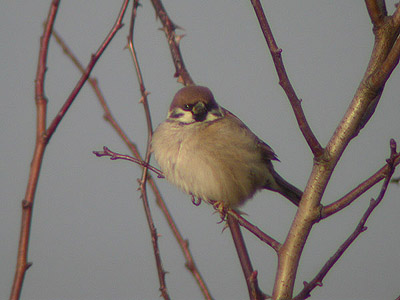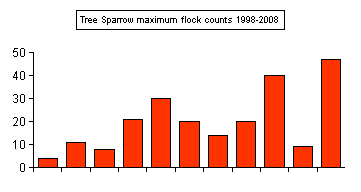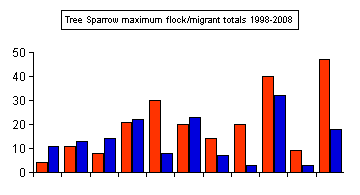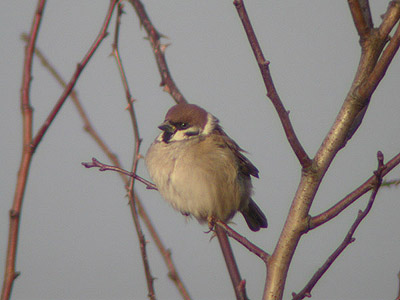

| The Tree Sparrow at Eakring 1998-2008 |
| For several years between 1998 and 2001, resident Tree Sparrow flocks at Eakring were consistantly outnumbered by small numbers of passage migrants during the Autumn. | ||
| .... | ||
| However, in 2002 there
was a substantial increase in the number of semi-resident
birds and post-breeding/over-wintering flocks which has
continued to exist since, although the presence of large
flocks remains rather sporadic. Despite the number of breeding Tree Sparrows in the Eakring area remaining extremely low, numbers have continued to show just a very slight increase Although the acreage of set-aside fields never really changed between 1998 and 2008, the increase in Tree Sparrow numbers from after 2002, is thought most likely to be attributable to the substantial increase in the planting of set-aside strips through the Stewardship Scheme. |
 |
|
| .... | ||
| These have
continued to remain in situ over a large part of the
area, with no immediate sign of them being removed as
part of the Government's ridiculous relaxation of
set-aside policies and guidelines, which is likely to
have an effect on several other species. Set-aside strips were introduced as part of the UK Government's Countryside Stewardship Scheme - a scheme which pays farmers to leave strips of land uncultivated around field-edges. Many such strips are planted with a carefully selected seed mixture. The mix is largely dependant on soil structure, type and conditions, but all mixtures are aimed at providing a variety of seed to attract and sustain many of our traditional farmland birds throughout the Winter months. |
||
| .... | ||
 |
The top graph shows the
maximum flock counts from 1998-2008. The general increase
in numbers is evident and we checked to see if there was
any correlation between the general increase in Tree
Sparrow flock totals and the number of Tree Sparrows
recorded during visible migration watches in the Autumn. Whilst there were some obvious similarities between the two graphs, when the total number of migrants recorded from August to November was used, we actually found very little correlation when only the figures for August and September were used. |
|
| .... | ||
 |
The majority of the
highest Tree Sparrow counts here, are largely
attributable to post-breeding flocks found in the area
during August and September. At this time of the year,
"pure" flocks of Tree Sparrow occur, but later
in the Autumn and continuing throughout the Winter
months, Tree Sparrows more often associate with a variety
of other species. Based entirely on observations from
1998-2008, these two species were primarily Chaffinch and
Yellowhammer. The highest ever counts are 47 at Eakring Field Farm/Penny Pasture Common on September 11th 2008 and 40 at Eakring Field Farm/Penny Pasture Common on September 9th 2006. Good years for Tree Sparrow passage were 2001, 2003 and 2006. |
|
| .... | ||
| It's not just Tree
Sparrows which have benefitted, as species such as
Yellowhammer have also increased during the past two
years. Mixed finch/bunting flocks are now occurring more
regularly during the colder months of the year. It's also obvious that highest counts are largely, only being produced by post-breeding flocks during August and September. At this time of the year, "pure" flocks of Tree Sparrows occur. Later in the Autumn and throughout the Winter months, birds tend to associate with a variety of other species (most often Chaffinch and Yellowhammer). Tree Sparrow flocks are also more mobile than most and certainly, birds commute around the area to feed on a daily basis. This is reflected by the fact that Tree Sparrow flocks rarely remain at any one site for too long a period |
 |
|
| Highest Tree sparrow counts and locations 1998-2008 |
| 1998 |
| Four at Eakring Flash March 14-23rd, three at Eakring Flash March 27th and four in area April 28th |
| 1999 |
| Four at Eakring Flash March 14th and 11 at Eakring Flash August 22nd |
| 2000 |
| Three at Eakring Flash August 27th, eight at Penny Pasture Common August 29th and six in area November 4th |
| 2001 |
| Eight at Red Hill April 13th and 21 at Tug Bridge Farm September 21-October 4th |
| 2002 |
| Nine at Penny Pasture Common September 5th, 16 around the pastures area September 11th, eight at Red Hill September 30th, 18 along the Kneesall Road December 18th and 30+ in set-aside along the Kneesall Road December 24th |
| 2003 |
| 14 at Penny Pasture Common August 12th, 13 at Eakring Flash August 13th, 10 at Eakring Flash August 31st, 14 in the Pastures area and eight around Tug Bridge Farm/Eakring Field Farm September 11th and 20 near Kersall September 25th |
| 2004 |
| 14 near Eakring Flash July 28th |
| 2005 |
| 20+ in set-aside along the Kneesall Road January 3-6th, 19 in the area March 19th and 14 at Penny Pasture Common September 1st |
| 2006 |
| Nine at Eakring Flash August 10th, 35 (two flocks) near Eakring Flash and at Penny Pasture Common August 22nd and 40 at Eakring Field Farm/Penny Pasture Common area on September 9th |
| 2007 |
| Nine at Red Hill on August 23rd 2007 |
| 2008 |
| 47 at Eakring Field Farm/Eakring Meadows September 11th and 20 at Red Hill September 18th |
| Summary Though Tree Sparrow numbers here remain low when viewed alongside other counts produced elsewhere in Nottinghamshire, the sudden improvement in records during 2002, continuing through 2003 and remaining well into 2008, does lend an air of optimism for the future. Not until breeding counts have risen substantially, will be safe to say that the Tree Sparrow's future as a breeding bird is more secure than it has been for many years. |
||